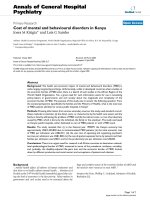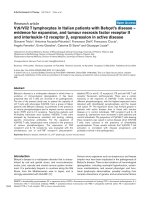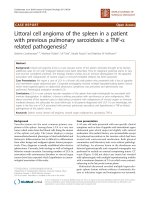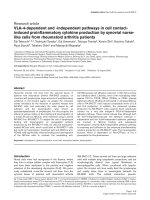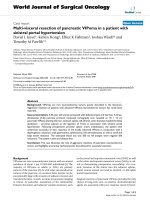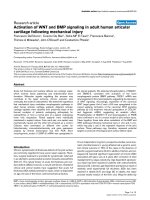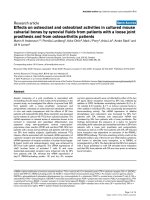Báo cáo y học: "Simultaneous sleep study and nasoendoscopic investigation in a patient with obstructive sleep apnoea syndrome refractory to continuous positive airway pressure: a case report" ppt
Bạn đang xem bản rút gọn của tài liệu. Xem và tải ngay bản đầy đủ của tài liệu tại đây (2.18 MB, 7 trang )
Journal of Medical Case Reports
Case report
Simultaneous sleep study and nasoendoscopic investigation
in a patient with obstructive sleep apnoea syndrome
refractory to continuous positive airway pressure:
acasereport
Claudia Chaves Loureiro*
1
, Marta Drummond
2
, Adriana Magalhães
2
,
Elisabete SantaClara
2
, Miguel Gonçalves
2
and João Carlos Winck
2
Addresses:
1
Department of Pulmonology, University Hospital of Coimbra, Coimbra, Port ugal and
2
Department of Pulmonology, São João do
Porto Hospital, Porto, Portugal
E-mail: Claudia Chaves Loureiro* - cl_loureiro@hot mail.com; Marta Drummo nd - ;
Adriana Magalhãe s - ; Elisabete SantaClara - ;
Miguel G onçalves - pneumologi ; João Carlos Winck -
*Correspondi ng a uthor
Publishe d: 2 December 2009 Received: 12 November 2009
Journal of Medical C ase Reports 2009, 3:9315 doi: 10.1186/1752-1947-3-9315
Accepted: 2 December 2009
This article is availa ble from: http:// www.jmedicalcasereports.com/content/3/1/9315
© 2009 Loureiro et al; licensee BioMed Central Ltd.
This is an Open Access art icle distributed under the terms of the Creative Commons Attributio n License (
/>which permits unrestricted use, distribution, and reproduction in any me dium, provided th e original work is properly c ited.
Abstract
Introduction: The standard treatment for obstructive sleep apnoea syndr ome is nasal
continuous positive airway pressure. In most cases the obstructio n is located at the oropharyngeal
level, and nasal continuous positive airway pressure is usually effective. In cases of non-response to
nasal continuous positive airway pressure other treatments like mandibular advancement devices
or upper airway surgery (especially bi-maxi llary advancement) may also be considered.
Case presentation: We report the case of a 38-year-old Caucasian man with severe obstructive
sleep apnoea syndrome, initially refractory to nasal continuous positive airway pressure (and
subsequently also to a mandibular advancement devices), in which the visual ization of the u pper
airway with sleep endoscopy and the concomitant titration of positive p ressure were useful in the
investigation and resolution of sleep disordered breathing. In fact, there was a marked reduction in
the size of his nasopharynx, and a paresis of his left aryepigl otic fold with hypert rophy of the rig ht
aryepiglotic fold. T he application of bi-level positive airway pressure and an oral interface
successfully managed his obstructive sleep apnoea.
Conclusion: This is a rare case of obstructive sleep ap noea syndrome refractory to treatment
with nocturnal ventilatory support. Visualization of the endoscopic changes, during sleep and under
positive pressure, was of great value to understanding the mechanisms of refractoriness. It also
oriented the therapeutic option. Refractoriness to obstructive sleep apnoea therapy with
continuous positive airway pressure is rar e, and each case should be ap proached individually.
Introduction
Obstructive sleep apnoea syndrome (OSAS) is characterized
by a recurrent collapse of all or some parts of the upper airway
during sleep. Despite being sub-diagnosed, it affects 2% to
4% of the world’s population [1] and has a higher prevalence
in obese peo ple [2]. This syn drome is as sociated with
increased cardiovascular risk. It is also an independent risk
factor for hypertension, myocardial infarction and stroke [3].
Page 1 of 7
(page number not for cit ation purposes)
BioMed Central
Open Access
The method for its initial evaluation using a cardio-
respiratory study is simple and easy to use on an
outpatient basis.
Nasal continuous positive airway pressure (nCPAP)
during sleep, which allows airway patency, is the current
standard treatment [4]. It significantly improves patients’
excessive daytime sleepiness, states of wake fulness,
cognitive abilities [5], and quality of life [6]. This
treatment also decreases cardiovascular risk, especially
when it is used for more than 4 hours daily [7].
Alternative treatments include a mandibu lar advance-
ment device (MAD) that increases the lumen of the
airway by inducing jaw and tongue protrusion during
sleep, improves the tone of the muscles of the airway,
and reduces the passive compliance of the pharyngeal
wall [8]. It is especially effective in non-obese patients
with moderate OSAS.
Upper airway surgery, specifically bi-maxillary surgery, is
also effective in severe cases of OSAS. It may be
considered for patients who are unwilling to use, or are
refractory to, nC PAP therapy and whose anatomical
changes are prone to surgical resolu tion [9]. This
approach must be made and addressed specificall y.
Case presentation
We report a 38-year-old Caucasian man who was referred
to our department for suspected OSAS with complaints of
severe snoring, respiratory pauses that were witnessed by
his wife, morning headaches, and adynamia, but without
acknowledgement of excessive daytime sleepiness.
He had a history of dyslipidemia treated with diet and
statin, without the existence of other cardiovascular risk
factors. He had low alcohol consumption (10 gr/day)
and no history of smoking. A physical exam revealed
macroglossia, a bulky soft palate and uvula. He was
overweightwithabodymassindex(BMI)of29.1and
had a cervical perimeter of 42 cm. As an initial diagnostic
approach, a spirometry and chest X-ray were performed,
which revealed no changes. A diagnostic cardiorespira-
tory study showed that in addition to extended p eriods
of snoring, he also had severe OSAS with an apnoea and
hypopnoea index (AHI) of 72.1/h, a desaturation index
of 67.1/h, and a minimum O2 saturation of 69%.
With the diagnosis o f severe OSAS, d espite the lack of
excessive d aytime sleepiness, a trial of positive airway
pressure (automatic mode) was proposed, with the
minimal pressure of 4 cmH2 0 and maximum pressure
of 15 cmH2 O. General measures of sleep hygiene and
weight reduction were also recommended. As an
alternative, the use of MAD was considered, and the
patient was referred to our hospital’s orthodontics
department.
The patient was evaluated after 3 months and there was
no adherence to treatment, with only 3 minutes of use
per night, with a total number of 6 days of use. The
patient att ributed this to his difficulty in adapting to the
masks and to the pressure itself.
MAD (Figure 1) was applied over the next 3 months.
During this period, our patient used the device daily for
3 to 4 hours per night, as limited by some salivation and
gum pain. His clinical symptoms, however, did not
improve.
For a better evaluation of our patient’ s clinical response,
we did a home cardiorespiratory study using MAD
(Figure 2), which showed no significant improvement in
his OSAS. (He had an AHI of 6 1.4/h and desaturation
index of 42.1/h with MAD duri ng the first 3.5 hours of
recording).
To titrate CPAP pressures and to better characterize our
patient’s sleep structure, we conducted a split-night
polysomnography. The first part of the night confirmed
the severity of our patient’sOSA(AHIof64.9/hwith
minimum O2 saturation of 29%). The second part
allowed a gradual increase of positive pressure, first in
continuous mode (CPAP) for up to 16 cmH2O, t hen in
the bilevel mode (BiPAP) with a maximum inspiratory
pressure (IPAP) of 24 cmH2O and a maximum
expiratory pressure (EPAP) of 20 cmH2O. Persistent
obstructive events with marked desaturation, with a
minimum O2 saturation of 45% in CPAP mode and of
82% in BiPAP mode (Figure 3) were prevalent.
Figure 1
An example of a mandibular advancement device.
Journal of Medical Case Reports 2009, 3:9315 />Page 2 of 7
(page number not for cit ation purposes)
Since the nocturnal titration was ineffective, a retitration
of pressures was conducted during the day to confirm
this refractoriness and optimize the interface. At that
moment the patient was prescribed bilevel-positive air
pressure (VIVO 30, Breas) with 20 cmH2O of IPAP and
12 cmH2O o f EPAP and a gel face mask (Mojo).
After a period with these settings, the patient’ s symptoms
remained, but he developed a newly diagnosed hyper-
tension, which was treated with antihypertensive med-
ication. Home nocturnal oximetry (in bilevel mode with
those parameters) maint ained episodes of desaturation,
suggesting a large number of resi dual apnoea and/or
hypopnoea events (Figure 4).
His refractoriness led to further investigations which
were done using two m ethods of evaluation. In the first
one, a facial computed tomography (CT) revealed a
smaller upper airway (Figure 5). Reformatting (Figure 6 )
showed an angular dysmorphia at the hypopharynx [10].
Thesecondmethodusedsleepnasoendoscopy(Figure
7) with concomitant polysomnography and titration of
ventilatory support pressures (Figure 8) [6]. In this
evaluation, the patient was able to sle ep effectively, and
a marked reduction of the size of the nasopharynx and a
paresis of the left aryepiglotic fold with hypertrophy of
the right one (Figure 7A) were noted. Extended periods
of vibration of the walls o f the oropharynx related to
snores were also observed. With the establishment of
positive pressure v entilation , a subocclusi on of the
nasopharynx persisted (up t o IPAP/EPAP levels of 24/
16 cmH2O). An unrolling of the epiglottis that collapsed
the airway and provoked periods of O2 desaturation
(Figur e 7C) was noted a few times. Th ese episodes
improved under 20 cmH20 IPAP and 1 3 cmH20 EPAP
with an Oracle® mask. A home oximet ry under a bilevel
mode with these pressures and interfac e (Figure 9)
revealed a significant improvement in o ur patient’s
nocturnal desaturation episodes.
Discussion
Refractoriness of OSAS therapy is rare and its approach
shouldbetargetedtospecificindividuals.
The conventional method for administering CPAP is
using a nasal or oronasal interface [11] based on
Figure 2
A cardiorespiratory study in the use of a mandibular advancement device. An evaluation at 4 months with a
cardiorespiratory study in the use of a mandibular advancement device (first 3.5 h of study) showed no significant
improvement in the patien t's obstructive sleep apnoea syndrome (apnoea and hypopnoea index at 61.4/h and desaturation
index of 42.1/h). A severe condition of obstructive sleep apnoea syn drome was observed with and witho ut the use of the
device.
Journal of Medical Case Reports 2009, 3:9315 />Page 3 of 7
(page number not for cit ation purposes)
Figure 3
Split-night polysomnography: Obstructive sleep apnoea syndrome refractoriness with continuous positive
airway pressure and bilevel positive airway pressure, nasal mask. (Evaluation at 4 months). The first part of the nig ht
confirmed the severity of obstru ctive sleep apnoea syndrome (apnoea and hypop noea index of 64.9/h with minimum O2
saturation of 29%). The second part allowed a gradual increase in positive pressure, first in continuous positive airway pressure
for up to 16 cmH2O, then in bilevel positive airway pressure with a maximum inspiratory pressure of 24 cmH2O and a
maximum expiratory pressure of 20 cmH2 O. There were persistent o bstructive events with marked desaturation (minimum
O2 saturation of 45% in continuous mode and of 82% in bilevel mode).
Figure 4
A home nocturnal oximetry (in bilevel mode) with nasal mask. (Evaluation at 5 months). A home nocturnal oximetry
(in bilevel mode, inspiratory pressure of 20 cmH2O and expiratory pressure of 12 cmH2O, and a gel face mask (Mojo) shows
episodes of desaturati on suggesting a large number of residual apnoea and/or hypopnoea events.
Journal of Medical Case Reports 2009, 3:9315 />Page 4 of 7
(page number not for cit ation purposes)
increasing intram ural pressure above a crit ical poi nt of
oropharynx collapse (PCrit) [12]. Patients’ compliance
to treatment is somewhat constrained by the side effects
associated with the use of these interfaces, such as nasal
congestion, dryness of the oronasal mucosa, epistaxis,
and claustrophobia. The oral route is an alternative that
canbeusedincaseswherethepatientisintolerantto
conventional approaches [13].
According to recent literature [14], the air acts as a
resistor to the physiological nasal obstruction which
produces collapsing forces that manifest at the most
collapsible point, the pharynx. Positive pressure applied
through the nos e has to ove rcome t he PCr it that re sul ts
from the composition of pressure at the point of collapse
of the airway and the surrounding soft tissue. Because
the soft palate is complacent, the PCrit to be overcome is
similar to the positive pressure that is applied through
the mouth. The Oracle mask (Fisher and Paykel) has
shown to be effective in the treatment of OSAS [1 3], as it
applies a pressure-flow relatio nship to the oropharynx
Figure 5
A facial computed tomography at 5.5 months
following the initial presentation shows a smaller
upper airway.
Figure 6
A facial computed tomography reformation at 5.5
months after the initial presentation shows an
angular dysmorphia at the hypopharynx level.
Figure 7
(A) Sleep endoscopy before ventilation. Extended
periods of vibration of the walls of the oropharynx related to
snores were observed. With the establishment of positive
pressure ventilation, the nasopharynx subocclusion persisted
up to 24 cmH2O inspiratory pressure and 16 cmH2O
expiratory pressure. An unrolling of the epiglottis that
collapsed the airway and provoked periods of O2
desaturation was also noted. (C) Sleep nasoendoscopy
under continuous positive airway pressure with P > 16
cmH2O at 6 months after the initial presentation. In this
evaluation, a marked r eduction of the size of t he
nasopharynx, and a paresis of the left aryepiglotic fold with
hypertrophy of the right one were noted.
Journal of Medical Case Reports 2009, 3:9315 />Page 5 of 7
(page number not for cit ation purposes)
similar to that of th e nasal way and imposes no obvious
changes in the superi or airway [15]. It also has the
advantage of fewer side effects.
In this particular case, the visualization, during sleep and
under positive pressure, of the endoscopic changes, was
of great value to the understanding of the mechanisms of
refractoriness.
The application of a positive pressure in an airway with
anatomical changes (such as occurred in the case
described) could perhaps have caused valve mechanisms
Figure 8
A polysomnography study during sleep endoscopy at 6 months after the initial presentation. A polysomnography
and titration of ventilatory support pressures were also performed during sleep endoscopy.
Figure 9
A nocturnal oximetry under inspiratory pressure of 2 0 cmH20, expiratory pressure of 13 cmH20 with Oracle®
at 6.5 months after the initial presentation. A home oximetry under bilevel mode, inspiratory pressure of 20 cmH20 and
expiratory pressure of 13 cmH20 and Oracle® mask revealed a significant improvement in nocturnal desaturation episodes.
Journal of Medical Case Reports 2009, 3:9315 />Page 6 of 7
(page number not for cit ation purposes)
that led to the unrolling of the epiglottis, with
consequent obstruction to the passage of air. This
phenomenon has become more evident with pressure
levels greater than 16 cmH2O. At the same time, with
lower pressures, the patency of the airway was not
established.
Based on these findings, the clinical decision to admin-
ister bilevel positive pressure during sleep through an
oral mask, which is not usually used in patients with
OSAS, overcame the major collapse of our patient’s
nasopharynx.
Conclusion
We describe a rare case of OSAS with refractoriness to
treatment with nocturnal ventilatory suppor t and
emphasize the importance of endoscopic visualization
of the upper airway during sleep in order to clarify the
origin of refractoriness and concomitantly orient the
treatment.
Consent
Written infor med c ons ent was obtained fro m t he pa tien t
for publication of this case report and any accompanying
images. A copy of the written consent is available for
review by the Editor-in-Chief of this journal.
Competing interests
The authors declare that they have no competing
interests.
Authors’ contributions
CL analyzed and interpreted the patient data regarding
OSAS and reviewed the existing literature on t his issue.
MD also analyzed and interpreted the patient data and
was a major contributor in writing the manuscript. AM
performed the sleep nasoendoscopy. MG performed the
adaptation to noninvasive ventilation. ESC analyzed the
polyssonographic data. JW orientated the investigation
and therapeutic options and was a major contributor in
writing the manuscript. All authors read and approved
the final manuscript.
References
1. Young T, Palta M, Dempsey J, Skatr ud J, Weber S and Badr S: Th e
occurrence of sleep-disordered breathing among middle-
aged adults. N Engl J Med 1993, 328:1230–1235.
2. Van Boxem TJM and de Groot GH: Prevalence and severity of
sleep-disordered breath ing in a group of morbidly obese
patients. Neth J Med 1999, 54(5):202–206.
3. Nieto FJ, Young TB, Lind BK, Shahar E, Samet JM, Redline S,
Dágostino RB, Newman AB, Le bowitz MD and Pickering TG:
Association of sleep-disordered breathing, sleep Apnoea,
and hyper tension in a large community-based study: sleep
hea rt health study. JAMA 2000, 283(14):18 29–1836.
4. Parish JM and Somers VK: Obstructive sleep apnoe a and
cardiovascular disease. Mayo Clin Pr oc 2004, 79(8):1036–1046.
5. Chisholm E and Kotecha B: Oropharyngeal surgery for
obstrucive sleep apnoea in CPAP failures. Eur Arch Otorhi nolar-
yngol 2007, 264:51–55.
6. BaishA,HeinG,GoblerJ,MaurerTandHormannK:Finding the
appropriate therapy with the help of sleep endoscopy.
Laryngo-Rhino-Otol 2005, 84:833–837.
7. Loj ander J, Räsänen P, Sintonen H, Roine RP and HUS QoL Study
Group: Effect o f nasal continuous positive airway pressure
therapy on health related quality of life in sleep apnoea
patients treated in the routine clinical setting of a university
hospital. JIntMedRes2008, 36(4):760–770.
8. Santamaria J, Iranzo A, Ma Montserrat J an d de Pablo J: Persistent
sleepiness in CPAP treated obstructive sleep apnoea
patients: evaluation and treatment . Sleep Med Rev 2007,
11(3):195–207.
9. Baptista PM: Surgery for obstructive sleep apnoea. An Sist Sanit
Navar 2007, 30(Suppl 1):75–88.
10. Maurer JT, Stuck BA, Hein G and Hormann K: Videoendoscopic
assessment of uncommon sites of upper airway obstruction
during sleep. Sleep Breath 2000, 4( 3):131–136.
11. Petri N, Svanholt P, Solow B and Winkel P:
Mandibular
advancement appliance for obstructive slee p apnoea: results
of ra ndomised placebo controlled trial using par allel group
design. J Sleep Res 2008, 17(2):221–229.
12. Rama NA, Tekwani SH and Kushida CA: Sites of obstruction in
obstructive sleep apnoea. Chest 2002, 122:1139–1147.
13. Smith LP, O’DonnellCP,AllanLandSchwartzAR:A physiologic
comparison of nasal and oral positive airway pressure. Chest
2003, 123:689–69 4.
14. McNicholas WT: The nose and OSA: variable nasal obstruc-
tion may be more important in pathophysiology than fixed
obstruction. EurRespirJ2008, 32:3–8.
15. Khanna R and Kline LR: A prospective eight-week trial of nasal
interfaces versus a novel oral interface (Oracle) for treat-
ment of obstructive sleep apnoea hypopnoea syndrome.
Sleep Med 2003, 4(4):333–338.
Publish with BioMed Central and every
scientist can read your work free of charge
"BioMed Central will be the most significant development for
disseminating the results of biomedical research in our lifetime."
Sir Paul Nurse, Cancer Research UK
Your research papers will be:
available free of charge to the entire biomedical community
peer reviewed and published immediately upon acceptance
cited in PubMed and archived on PubMed Central
yours — you keep the copyright
Submit your manuscript here:
/>BioMedcentral
Journal of Medical Case Reports 2009, 3:9315 />Page 7 of 7
(page number not for cit ation purposes)



